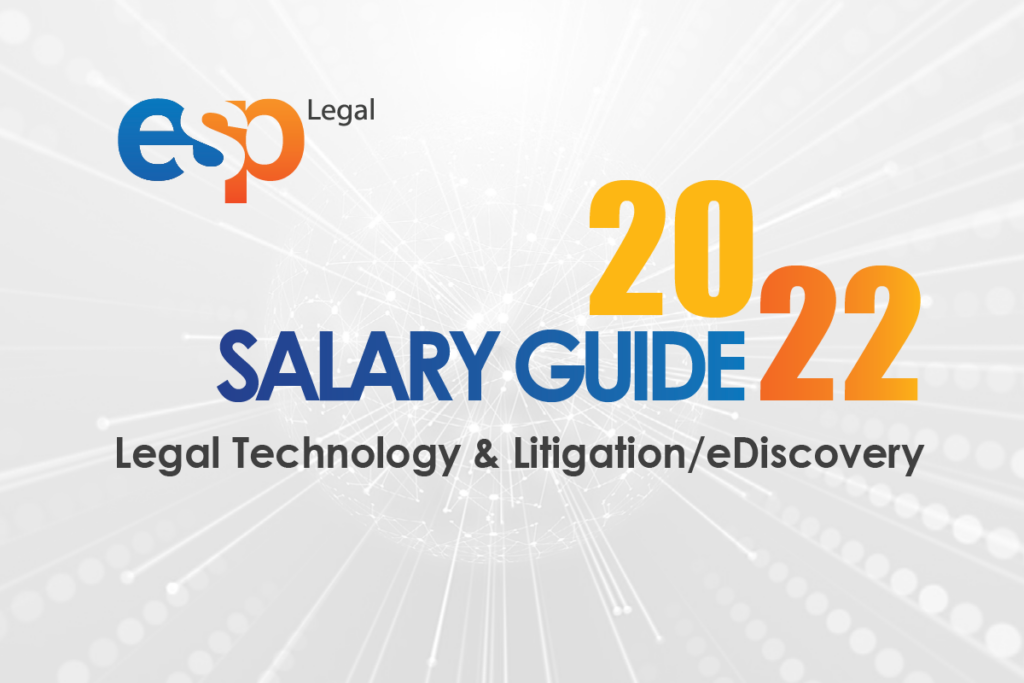Our 2022 Technology & Litigation/eDiscovery Salary Guide presents data gathered and analyzed from law firms ranging from small and mid-sized law firms with a handful of legal technology professionals to AM 100 & AM 200 law firms with hundreds of technology staff. We compared our numbers, using actual salaries from our recent placements, with other national resources and determined the base salary rates from 2021. Our data shows that AM 100/200 Law Firms increased legal technology salaries by 7.7%, eDiscovery and Litigation Support roles salaries by 6%, and Executive Leadership and Key Management salaries by 8.9%, while small and mid-sized firms saw legal technology and litigation salaries increase by 7.7%. Bonuses and benefits including healthcare coverage, PTO, and remote and flexible work options continue to be important for retaining and attracting legal technology talent in a competitive market.
View Legal Technology and Litigation/eDiscovery Salary Guide
Retention and Attraction
2021 saw an increase in legal technology professionals willing to leave the security of their current positions and seek new roles. While the “Great Resignation” has not been a huge factor within law firm technology and eDiscovery teams, we have noticed that about 60% of the roles we’ve been asked to fill this year have been replacements for employees who have left for other opportunities. Many law firms are also growing their IT and litigation support departments, leading to new opportunities for technology experts in the legal niche. Amidst the high demand for technology and litigation professionals, offering higher salaries and bonuses has been instrumental in law firms securing the best talent.
 In addition to higher pay, job seekers are also looking for employers who align with their own values, which include a desire for diversity, career growth opportunities, flexible work schedules, and mental health resources. In an article about how tech companies have successfully retained and attracted talent in the midst of labor shortages, common practices included: prioritizing and recruiting underrepresented candidates, extending offers to successful candidates more quickly, transparently offering consistent salaries for same-level roles, and emphasizing the employee experience.
In addition to higher pay, job seekers are also looking for employers who align with their own values, which include a desire for diversity, career growth opportunities, flexible work schedules, and mental health resources. In an article about how tech companies have successfully retained and attracted talent in the midst of labor shortages, common practices included: prioritizing and recruiting underrepresented candidates, extending offers to successful candidates more quickly, transparently offering consistent salaries for same-level roles, and emphasizing the employee experience.
Benefits Snapshot
Benefits continue to be an essential factor for legal professionals’ decisions around employment. The pandemic has shifted what many employees consider to be an ideal work-life balance, what they want from an employer or job, and what benefits they value most. But there’s a gap between what employers believe employees want, and what they really do.

One of the biggest gaps we’ve observed is around remote work. The desire for remote and flexible work options has risen considerably over the last two years as individuals have experienced the perks of working from home, including saving time and money on commuting and a decrease in lost productivity due to picking up a sick child from school or other similar interruptions. But whereas many employees would like to work from home three to four days a week—if not 100% remotely—many law firms’ hybrid plans are only offering two days at home, with some technical support roles requiring 100% in person. Law firms offering hybrid or remote work options aligned with employee desires will be the most successful in attracting legal technology talent.
It may be no surprise that in addition to remote work, jobs seekers value paid vacation (85%), paid sick leave (80%), training and education benefits (68%), and health care benefits (85%) including dental (81%). What differentiates average and great benefits in the minds of legal technology professionals? Our network of professionals is generally looking for low medical costs, three to four weeks of paid vacation, a bonus potential of 10-15%, and retirement plans with 7-10% profit-sharing contributions.
High Demand and Growth Areas
In the last year, we’ve seen increased demand in the areas of Information Security, eDiscovery/Litigation Support, and Network Infrastructure. In addition, several positions within technology have unemployment rates below 2%, including Information Security Analyst, Database Administrator, and Network Architect.
With over twenty-five years of legal technology staffing expertise, we continue to monitor and analyze hiring trends, including compensation and benefits in this rapidly changing economy in order to best serve you.



